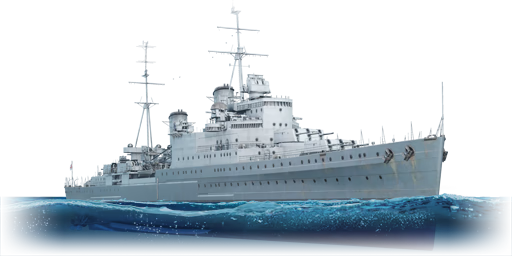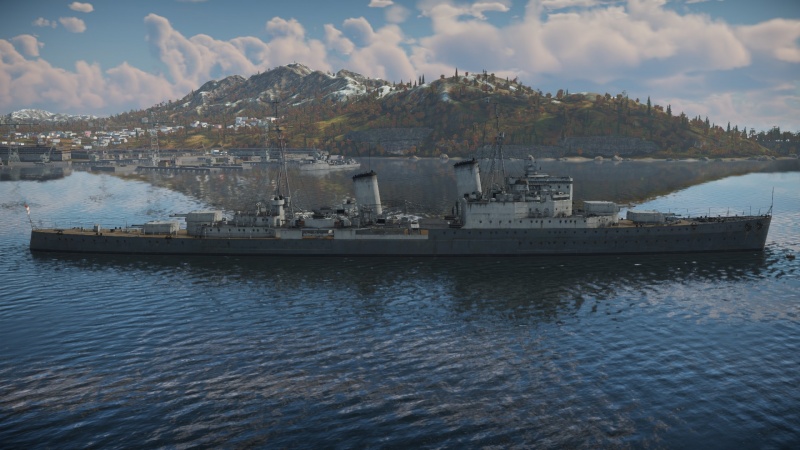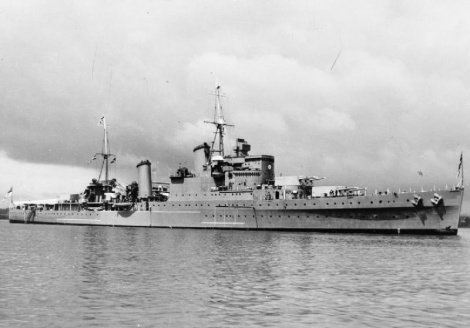HMS Southampton
Contents
Description
The Town-class, HMS Southampton (C83), 1940 is a rank British light cruiser with a battle rating of (AB), (RB), and (SB). It was introduced in Update 1.89 "Imperial Navy".
The Southampton is the lead ship of the Southampton-class of light cruisers, a part of what became known as the Town-class that were the most capable light cruisers available to the Royal Navy at the outbreak of World War II. Compared to previous British light cruisers such as the Leander and Arethusa, the Southampton is a substantial advance in terms of firepower and protection.
General info
Survivability and armour
The Southampton has much better overall protection than previous British light cruisers. The machinery is protected by a thick 114 mm citadel belt, with 63.5 mm ends. This provides good protection against even heavy cruiser guns at longer ranges when angled. However, the deck armour over the machinery is only 31 mm thick, which is mostly enough to protect against long range light cruiser fire, but not much more.
The main gun magazines are protected within armoured boxes, with 114 mm upper and 76 mm lower side protection. The roofs of the boxes are protected by 51 mm of armour. Altogether, the magazines are very well protected against light cruiser fire, and are difficult to penetrate even with heavy cruiser guns at range and when angled. The shell rooms adjacent to the magazines are much more lightly protected, at only 25.4 mm anti-fragmentation armour, but a hit there, while causing serious damage, will not be immediately fatal to the ship, unlike a magazine penetration.
The rest of the ship is much more lightly protected. The light turret and barbette protection remains a serious Achilles heel of the ship, like on preceding British light cruisers. It is only 25 mm thick, making even destroyer AP/SAP/Common shells a potential threat. Like almost all British cruisers, the Southampton also has an open bridge with only minimal splinter protection (6-9 mm). This makes her very vulnerable to getting disabled and losing crew to hits to the bridge, especially with HE shells.
The Southampton has a crew complement of 748 men, which is small compared to other light cruisers like the USS Cleveland or her half-sister-ship Belfast.
Mobility
The Southampton is a little slower compared to the other British cruisers at the same BR, though her speed remains fairly respectable for a ship of her size. Her handling and acceleration are about average.
| Mobility Characteristics | |||
|---|---|---|---|
| Game Mode | Upgrade Status | Maximum Speed (km/h) | |
| Forward | Reverse | ||
| AB | |||
| Upgraded | |||
| RB/SB | |||
| Upgraded | |||
Modifications and economy
Armament
Primary armament
The main armament of the Southampton consists of four turrets with triple BL 6-inch Mark XXIII guns. These guns have a high sustained rate of fire at 8 rounds/minute with the best possible crew. Due to the large number of barrels and high rate of fire, the Southampton is capable of throwing nearly 100 6-inch shells per minute at a target. The gun accuracy at medium ranges is reasonable, although the horizontal dispersion is quite noticeable. These guns can also elevate to 45 degrees, which allows them to be used to reasonable effect against aircraft, especially once HE-VT is available. The turrets all have a below-average traverse arc of only 145 degrees to each side, which means that the Southampton has to show more broadside than most other light cruisers in order to unmask all her guns.
The main guns have a selection of four shells: HE, HE-TF, HE-VT, and CPBC. The explosive fillers for the HE, HE-TF, and HE-VT shells are identical (a respectable ~4 kg TNT), with the HE shell being slightly better at setting fires to ships, while the HE-TF and HE-VT have higher shrapnel counts and can burst on air targets. There is little point in using the HE-TF shell once HE-VT is unlocked, since the latter is not dependent on accurate rangefinding and is therefore a much superior anti-aircraft shell. The CPBC semi-armour piercing shell combines a decent filler for a 6-inch shell (~1.87 kg TNT equivalent) with respectable penetration, and is the shell of choice against enemy cruisers.
Ammunition
| Penetration statistics | |||||||
|---|---|---|---|---|---|---|---|
| Ammunition | Type of warhead |
Penetration @ 0° Angle of Attack (mm) | |||||
| 1,000 m | 2,500 m | 5,000 m | 7,500 m | 10,000 m | 15,000 m | ||
| 6 inch HE | HE | 37 | 37 | 37 | 37 | 37 | 37 |
| 6 inch CPBC | SAPBC | 197 | 172 | 137 | 110 | 90 | 67 |
| 6 inch HE-TF | HE-TF | 37 | 37 | 37 | 37 | 37 | 37 |
| 6 inch HE-VT | HE-VT | 37 | 37 | 37 | 37 | 37 | 37 |
| Shell details | ||||||||||||
|---|---|---|---|---|---|---|---|---|---|---|---|---|
| Ammunition | Type of warhead |
Velocity (m/s) |
Projectile mass (kg) |
Fuse delay (s) |
Fuse sensitivity (mm) |
Explosive mass (TNT equivalent) (kg) |
Ricochet | |||||
| 0% | 50% | 100% | ||||||||||
| 6 inch HE | HE | 841 | 50.8 | 0 | 0.1 | 3.96 | 79° | 80° | 81° | |||
| 6 inch CPBC | SAPBC | 841 | 50.8 | 0.025 | 7 | 1.7 | 48° | 63° | 71° | |||
| 6 inch HE-TF | HE-TF | 841 | 50.8 | 0 | 0.1 | 3.96 | 79° | 80° | 81° | |||
| Proximity-fused shell details | ||||||||||||
|---|---|---|---|---|---|---|---|---|---|---|---|---|
| Ammunition | Type of warhead |
Velocity (m/s) |
Projectile mass (kg) |
Fuse delay (m) |
Fuse sensitivity (mm) |
Arming distance (m) |
Trigger radius (m) |
Explosive mass (TNT equivalent) (kg) |
Ricochet | |||
| 0% | 50% | 100% | ||||||||||
| 6 inch HE-VT | HE-VT | 841 | 50.8 | 0 | 0.1 | 240 | 16 | 3.96 | 79° | 80° | 81° | |
Secondary armament
The Southampton's secondary armament consists of eight QF 4-inch Mark XVI guns in four twin gun mounts, with two mounts on each side of the ship. These guns are most effective against aircraft, especially with HE-VT, although their high rate of fire (20 rounds per minute maximum each) can also make them a threat to coastal craft and even lighter destroyers.
| Penetration statistics | |||||||
|---|---|---|---|---|---|---|---|
| Ammunition | Type of warhead |
Penetration @ 0° Angle of Attack (mm) | |||||
| 1,000 m | 2,500 m | 5,000 m | 7,500 m | 10,000 m | 15,000 m | ||
| 4 inch HE | HE | 20 | 20 | 20 | 20 | 20 | 20 |
| 4 inch SAP | SAP | 102 | 85 | 64 | 48 | 38 | 30 |
| 4 inch HE-TF | HE-TF | 20 | 20 | 20 | 20 | 20 | 20 |
| 4 inch HE-VT | HE-VT | 20 | 20 | 20 | 20 | 20 | 20 |
| Shell details | ||||||||||||
|---|---|---|---|---|---|---|---|---|---|---|---|---|
| Ammunition | Type of warhead |
Velocity (m/s) |
Projectile mass (kg) |
Fuse delay (s) |
Fuse sensitivity (mm) |
Explosive mass (TNT equivalent) (g) |
Ricochet | |||||
| 0% | 50% | 100% | ||||||||||
| 4 inch HE | HE | 811 | 15.88 | 0 | 0.1 | 1,550 | 79° | 80° | 81° | |||
| 4 inch SAP | SAP | 811 | 17.35 | 0.015 | 5 | 600 | 47° | 60° | 65° | |||
| 4 inch HE-TF | HE-TF | 811 | 15.88 | 0 | 0.1 | 1,550 | 79° | 80° | 81° | |||
| Proximity-fused shell details | ||||||||||||
|---|---|---|---|---|---|---|---|---|---|---|---|---|
| Ammunition | Type of warhead |
Velocity (m/s) |
Projectile mass (kg) |
Fuse delay (m) |
Fuse sensitivity (mm) |
Arming distance (m) |
Trigger radius (m) |
Explosive mass (TNT equivalent) (g) |
Ricochet | |||
| 0% | 50% | 100% | ||||||||||
| 4 inch HE-VT | HE-VT | 811 | 15.88 | 0 | 0.1 | 274 | 18 | 1,550 | 79° | 80° | 81° | |
Anti-aircraft armament
Complementing the 4-inch and 6-inch guns in the anti-aircraft role are two quadruple QF 2-pounder Mark VIII "pom-pom" mounts located on each side of the first funnel and two quadruple Vickers .50 cal heavy machine gun mounts on each side of the rear mast. The "pom-poms" can put out a lethal amount of 40 mm shells against aircraft or coastal craft that dare approach within effective range, but they have a substantial reload time once empty. The heavy machine guns are less effective, but can still be a deterrent at close ranges.
Additional armament
The Southampton has two triple torpedo tubes, one on each side of the ship. These fire the 21-inch Mark IX torpedo which has a speed and range of 67 km/h and 9.6 km, respectively (56 km/h and 12.34 km with the torpedo mode installed). The warhead is a hefty 340 kg TNT, and can be a threat to even battleships.
Scout plane
Usage in battles
The Southampton is a quantum leap over the previous British light cruisers in terms of firepower. She has 50% more main gun firepower than her predecessor, the Leander. The combination of a large number of barrels, high rate of fire, and decent shell explosive fillers makes her a very deadly opponent at short/medium ranges, especially to destroyers. She also maintains a respectable torpedo armament, allowing her to threaten even battleships if they get within effective torpedo range.
The protection is a bit more of a mixed bag. It is very hard to quickly destroy the Southampton due to her excellent magazine and belt protection, but the thin turret armour and unarmoured bridge mean that she is quite easy to disable and will tend to lose a lot of crew through turret and bridge disables. This is further exacerbated by the small crew complement. The ship itself has quite a large profile, and thus it is harder to take advantage of cover. She also has somewhat poor turret traverse arcs, which means she has to show a lot of broadside in order to use all of her turrets.
As she is depicted in her early-war configuration, the anti-aircraft suite of the Southampton is quite underwhelming, especially compared to the previous British cruisers and her sister-ship Liverpool. This can be compensated to some extent with the main and secondary guns and good aim, since they have access to effective HE-VT shells, but the close-range anti-aircraft guns should not be relied upon, especially under AI control.
It is important to note that the Southampton can be matched against battleships at its battle rating. The 6-inch guns are mostly ineffective against battleships beyond setting fire to them with HE, so it is best to avoid fighting them head-to-head at all costs. The torpedoes are also an option if a battleship carelessly allows the Southampton to get within effective range.
Pros and cons
Pros:
- Large broadside of 12 gun
- High rate of fire for main guns
- Large explosive filler in SAPCPBC rounds with effective penetration
- Thick magazine protection and machinery belt armour
- Access to HE-VT shells for both main and secondary guns
- Large torpedo warheads
Cons:
- Below average close-range anti-aircraft armament
- Below average turret traverse arcs
- Small crew complement
- Thin turret and non-existent bridge protection
- Large ship profile, and hence a large target
- Can face battleships
History
The HMS Southampton, pennant number 83, is a light cruiser of the Town class. Launched in 1936, she went on to see service during the Second World War. She initially served as the flagship of the 2nd Cruiser squadron of the Home Fleet, and later participated in several engagements with German vessels. She was reassigned to the Mediterranean in October of 1940. However, in January 1941, she was bombed by Italian aircraft and suffered crippling damage. As a result, she was scuttled with torpedoes from her escorts.[1]
Design and development
The Southampton was a member of the Town class, a group of light cruisers built in the 1930s. Initially intended to be built as Arethusa-class cruisers, the design was changed after the construction of the American Brooklyn-class and Japanese Mogami-class ships. The vessels were 180 metres long and displaced 11 000 tons, as they weren't regulated by the Washington naval treaty.[2] The ships carried an armament of twelve 152 mm guns in four triple turrets, a big upgrade from the six-gun Arethusas. The ships also carried numerous anti-aircraft defenses, and two triple torpedo launchers. She was capable of 32 knots (59 km/h).[2]
The HMS Southampton was laid down on November 11th 1934, and launched on March 10th 1936.[2] She was formally commissioned into the Royal Navy in March of 1937.[2]
Operational history
Following her commissioning, the Southampton entered service with the 2nd Cruiser squadron of the British Home Fleet. After the outbreak of the Second World War, she participated in the hunts for the German merchant Johannes Molkenbuhr and the battlecruisers Scharnhorst and Gneisenau. During this time, she was damaged twice; first by a 500kg bomb while she was laid up at Rosyth, and later by a German air attack off the coast of Norway.[1]
In November of 1940, Southampton sailed for the Mediterranean. She later participated in the Battle of Cape Spartivento and escorted resupply missions to Malta. However, on January 11th of 1941, she was attacked by twelve Stukas of the Luftwaffe. Hit by two bombs, the ship caught fire and suffered severe damage. With 80 sailors dead and no electrical power, the decision was made to scuttle the ship. Thus, she was sunk by four torpedoes from the cruiser Orion and a single torpedo from her sister ship Gloucester.[1]
Media
- Skins
- Videos
See also
Links to articles on the War Thunder Wiki that you think will be useful for the reader, for example:
- reference to the series of the ship;
- links to approximate analogues of other nations and research trees.
External links
References
- Citations
- Bibliography
- Helgason, G. (1995). HMS Southampton. Retrieved November 17, 2020, from https://uboat.net/allies/warships/ship/1235.html
- RBJ. (2008, January 01). Light cruiser HMS Southampton (C83). Retrieved November 18, 2020, from https://shipshub.com/ships/180-1.html
| John Brown & Company | |
|---|---|
| Destroyers | |
| Daring-class | HMS Diamond |
| Light Cruisers | |
| Emerald-class | HMS Enterprise |
| Town-class | HMS Southampton |
| Tiger-class | HMS Tiger |
| Battlecruisers | |
| Renown-class | HMS Repulse |
| Admiral-class | HMS Hood |
| Battleships | |
| Queen Elizabeth-class | HMS Barham |
| Britain light cruisers | |
|---|---|
| Emerald-class | HMS Enterprise |
| Dido-class | HMS Dido |
| Leander-class | HMNZS Leander |
| Arethusa-class | HMS Arethusa |
| Town-class | HMS Belfast · HMS Liverpool · HMS Southampton |
| Tiger-class | HMS Tiger |
| Abdiel-class* | HMS Abdiel |






